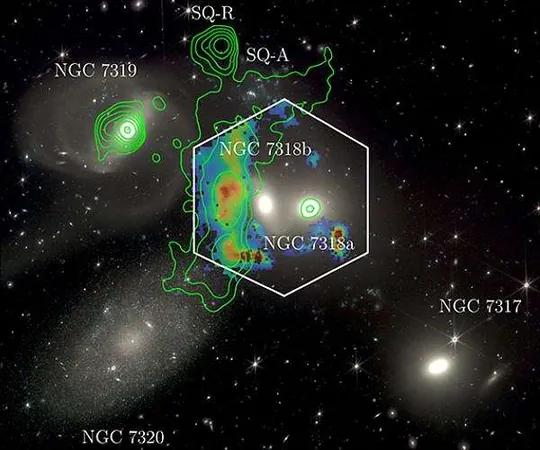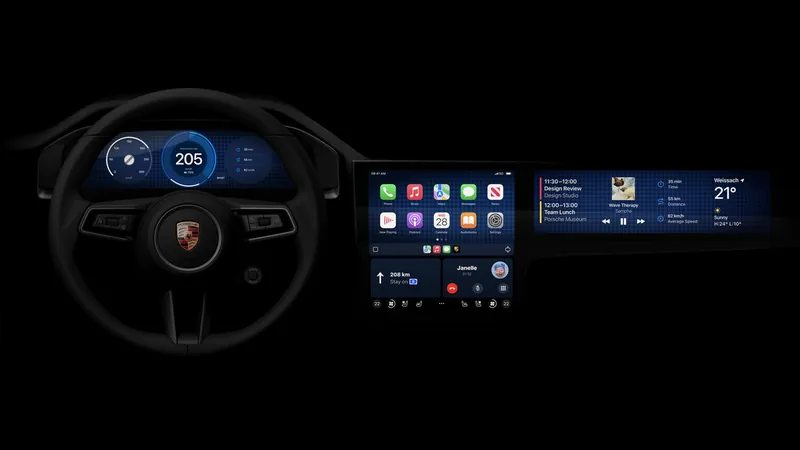
WEAVE Unveils Stunning New Insights into Galactic Collisions in Stephan's Quintet
2024-11-24
Author: Yu
Groundbreaking Study Unveils New Insights
A groundbreaking study using early data from the William Herschel Telescope's Enhanced Area Velocity Explorer (WEAVE) has provided astonishing insights into the dynamics of galactic collisions within Stephan's Quintet, a group of five interacting galaxies first discovered in 1877. This pivotal research, led by Dr. Marina Arnaudova of the University of Hertfordshire, marks a significant milestone in astronomical exploration and is the first major outcome generated by WEAVE.
Understanding Stephan's Quintet
Stephan's Quintet consists of five galaxies: NGC 7317, NGC 7318a, NGC 7318b, NGC 7319, and NGC 7320c, creating a dramatic cosmic setting characterized by fierce collisions and complex debris fields. The study particularly highlights NGC 7318b, which is barreling through space at an astonishing speed of over 3.2 million kilometers per hour. This rapid movement has generated a colossal shockwave—akin to the sonic boom produced by a jet—which serves as a unique laboratory for researchers to study galactic interactions.
Unique Laboratory for Research
Dr. Arnaudova explained, 'This system presents an ideal laboratory to understand the chaotic and often violent relationships between galaxies.' The researchers employed WEAVE's Large Integral Field Unit (LIFU) to capture the first detailed observations of this phenomenon. Their findings were recently published in the renowned 'Monthly Notices of the Royal Astronomical Society (MNRAS)' and reveal a fascinating duality in the behavior of the shockwave generated by these galactic interactions.
Complex Shockwave Dynamics
As the shockwave traverses through regions of cold gas, it accelerates to hypersonic speeds, capable of stripping electrons from atoms and producing a trail of ionized gas that WEAVE detected. Conversely, when the shock moves through hotter gas, it weakens, compressing rather than disrupting it, which generates detectable radio waves. This contrasting behavior provides valuable insights into the nature of galactic collisions and their aftermath.
Implications for Galactic Formation
The data collected illustrates the complexities of shock dynamics within Stephan's Quintet, which could vastly enhance our understanding of galactic formations and evolutions. 'The level of detail uncovered here by WEAVE is remarkable,' noted Professor Gavin Dalton, Principal Investigator at RAL Space and the University of Oxford. He also emphasized the importance of these observations in shedding light on the formation of faint galaxies that are on the brink of discovery.
Technological Advancements in Astronomy
The WEAVE spectrograph was developed through a €20-million collaborative effort, spearheaded by the Isaac Newton Group of Telescopes (ING) and involving institutions across the UK, Spain, the Netherlands, France, and Italy. This innovative spectrograph will significantly contribute to large-scale surveys over the next decade by addressing crucial astrophysical questions.
Future Explorations of the Cosmos
In summary, the findings from the WEAVE project underscore the profound impact of advanced observation technologies on our understanding of galaxies and their interactions. With ongoing studies, astronomers are optimistic about revealing even more extraordinary secrets of the cosmos in the near future. Don’t miss the chance to follow this remarkable journey into the depths of space!




 Brasil (PT)
Brasil (PT)
 Canada (EN)
Canada (EN)
 Chile (ES)
Chile (ES)
 España (ES)
España (ES)
 France (FR)
France (FR)
 Hong Kong (EN)
Hong Kong (EN)
 Italia (IT)
Italia (IT)
 日本 (JA)
日本 (JA)
 Magyarország (HU)
Magyarország (HU)
 Norge (NO)
Norge (NO)
 Polska (PL)
Polska (PL)
 Schweiz (DE)
Schweiz (DE)
 Singapore (EN)
Singapore (EN)
 Sverige (SV)
Sverige (SV)
 Suomi (FI)
Suomi (FI)
 Türkiye (TR)
Türkiye (TR)